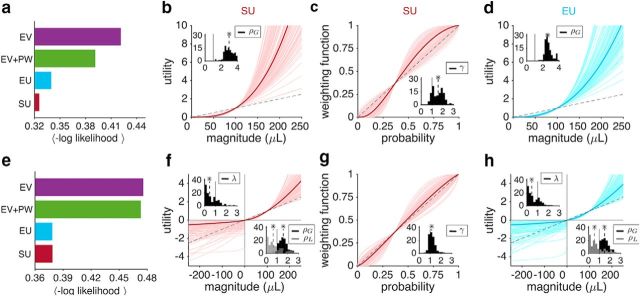Figure 6.
Fitting of choice behavior reveals a task-dependent pattern of risk attitudes different than what is predicted by prospect theory. a, Comparison of the goodness-of-fit for choice behavior during the juice-gambling task using four different models of subjective value: EV, EV+PW, EU, and SU. Plotted is the average negative log likelihood (−LL) per trial over all cross-validation instances (a smaller value corresponds to a better fit). The SU model provided the best fit. b, Estimated utility function based on the SU model as a function of the reward juice. Each curve shows the result of the fit for one session of the experiment; the thick magenta curve is based on the median of the fitting parameter. The dashed line is the unity line normalized by 100 μL. The insets show the distribution of estimated parameters for the utility curve for gains (ρG). The dashed lines show the medians and a star indicates that the median of the distribution is significantly different from 1 (two-sided sign test; p < 0.05). c, Estimated PW function based on the SU model. The inset shows the distribution of estimated parameters for the PW function (γ). The dashed line is the unity line. Subjects exhibited a pronounced S-shaped PW function. Figure 6-1) shows consistent results for fitting based on the EV+PW model. d, Estimated utility function based on the EU model. Conventions are the same as in b. e–h, Same as a–d, but for the token-gambling task. The EU and SU models provided the best fits and subjects exhibited a slightly S-shaped PW function based on the SU model. The reward magnitude in this task corresponds to the juice equivalent of a given number of tokens. The insets in f show the distribution of estimated parameters for the utility curves in the gain domain (ρG) and loss domain (ρL), as well as the loss aversion coefficient (λ). On average, subjects exhibited a convex utility function for both gains and losses and thus were loss seeking and violated the reflection effect.

